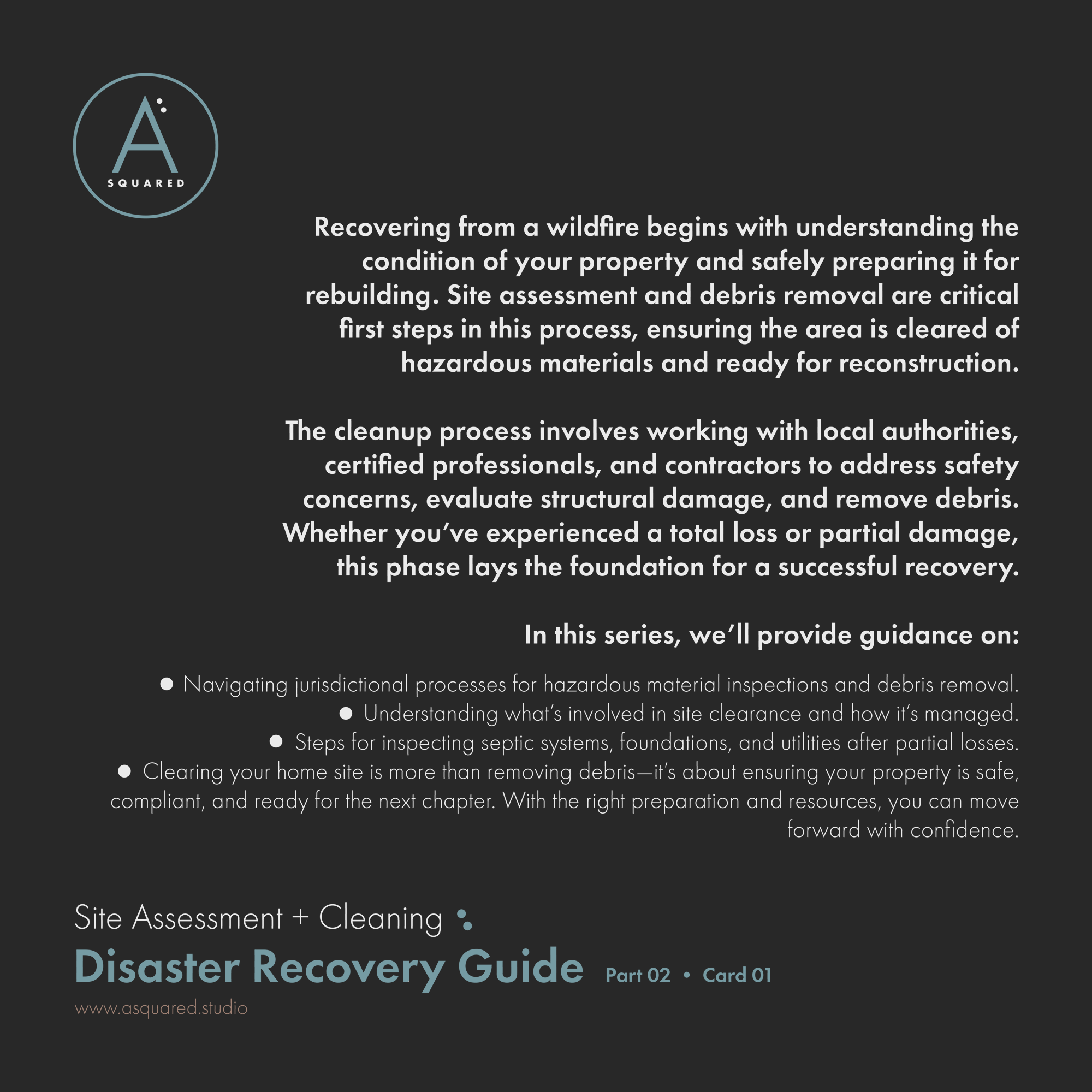
Part 2
Recovering from a wildfire starts with understanding the crucial steps for clearing your property and ensuring it’s ready for rebuilding. Site cleanup isn’t just about removing debris—it’s about addressing hazardous materials, assessing damage, and preparing your home for a safer future.
The cleanup process involves working with local authorities, certified professionals, and contractors to address safety concerns, evaluate structural damage, and remove debris. Whether you’ve experienced a total loss or partial damage, this phase lays the foundation for a successful recovery.
In Part 02 of this guide, we provide information on:
- Navigating jurisdictional processes for hazardous material inspections and debris removal.
- Understanding what’s involved in site clearance and how it’s managed.
- Steps for inspecting septic systems, foundations, and utilities after partial losses.
- Clearing your home site is more than removing debris—it’s about ensuring your property is safe, compliant, and ready for the next chapter. With the right preparation and resources, you can move forward with confidence.
Local Agencies
Los Angeles County Fire Department • Health Hazardous Materials Division (Fire-HazMat)
- Responsible for inspecting debris for hazardous materials. Property owners must wait for Fire-HazMat or local hazardous materials agencies to conduct inspections before removing debris
Los Angeles County Public Works
- Oversees debris removal operations and provides guidance on rebuilding processes. They offer programs for both government-assisted and private debris removal. For questions, contact the Debris Removal Hotline at (626) 979-5370
Federal Agencies
Federal Emergency Management Agency (FEMA)
- Provides financial assistance for debris removal and other disaster-related expenses. Following the recent wildfires, President Biden approved funds to cover 100% of the cost of debris removal and lifesaving activities undertaken by state and local governments
California Governor’s Office of Emergency Services (Cal OES)
- Coordinates state-level emergency response and recovery efforts, working alongside FEMA to support affected individuals and businesses
Public Works Department
Hazardous Materials Inspection
- Before any debris removal, Fire-HazMat or local hazardous materials agencies must inspect the property to identify and safely handle hazardous materials. Property owners are prohibited from removing debris until this inspection is completed
Debris Removal Operations
Debris Removal Operations • Option 1
- Government-Sponsored Program: CalRecycle, in coordination with Los Angeles County Public Works, offers a free debris removal service for eligible residents who opt into the program. This includes the removal of fire-related debris, including building foundations
Private Contractor (Opt-Out Program) • Option 2
- Residents who choose not to participate in the government-sponsored program can hire private contractors. However, they must submit a "Los Angeles County Local Fire Debris Removal Program Application" and a work plan to the county for approval
Debris Removal Contacts
Navigating the debris removal process requires coordination with these agencies to ensure safety and compliance with local and federal regulations. Engaging with them early can facilitate a smoother recovery journey
Debris Removal Hotline
626•979•5370
FEMA Assistance
Apply online at DisasterAssistance.gov or call 1•800•621•3362
Why Clearing Your Site Matters
- After a wildfire, the site may contain hazardous materials, ash, and structural debris that pose risks to health and safety
- Jurisdictions have specific processes for clearing hazardous materials—following these ensures safety and compliance
- Proper site clearance is the first step toward rebuilding
Understanding the Process
Contact your local authorities or environmental health department to determine:
- Who is responsible for clearing hazardous debris
- Whether cleanup is handled by the county/state or requires private contractors
Check if costs are covered by FEMA, state programs, or your insurance policy
- Tip: Participation in government-led cleanup programs may streamline the process, but ensure you understand deadlines and exclusions
Addressing Hazardous Materials
Wildfire sites may contain:
- Asbestos, lead, and toxic chemicals from burned materials
- Contaminated soil or water runoff
Certified hazardous waste teams assess and remove these materials to ensure safety
Do not attempt to clear debris on your own without professional guidance
Debris Removal • What To Expect
Debris removal typically occurs in two phases:
- Hazardous Materials Assessment and Removal• Handled by trained professionals
- General Debris Cleanup • Includes clearing structures, trees, and ash
If partial loss, ensure contractors avoid damaging salvageable components during cleanup
- Advice: Obtain a detailed debris removal plan from your contractor or jurisdiction to track progress.
Considerations For Partial Loss
Septic Systems
- Have a licensed professional inspect for damage or contamination
- Repairs or replacements may require permitting and compliance with local codes
Foundations
- Fire can compromise the structural integrity of concrete or masonry foundations
- Engage a structural engineer to assess and confirm reusability before rebuilding
Utilities
- Inspect underground utilities (gas, water, electrical) for fire-related damage.
- Work with utility providers to restore service safely
Questions During CleanUp
- Is my insurance covering debris removal and hazardous waste cleanup?
- Do I need permits for site clearing or septic system inspections?
- What documentation is required to show that the site is safe for rebuilding?
- Are there local grants or financial aid available for cleanup costs?
Working With Cleanup Contractors
Hire Licensed and Insured Professionals
- Check credentials with your state contractor licensing board
Get Multiple Bids
- Compare costs and timelines
Document Everything
- Take photos of the site before, during, and after cleanup for insurance and permitting records
Communicate Salvage Goals
- Clearly identify items or materials you wish to preserve
Moving Forward After Cleanup
After Site Clearance + Certification
- Apply for rebuilding permits based on your jurisdiction's requirements
- Schedule soil and foundation inspections to ensure a stable base for new construction
- Begin working with your Architect to develop a rebuild plan that incorporates fire-resistant design
- Remember: Clearing the site is just the beginning of the journey to recovery. Each step ensures a safer, stronger foundation for your future home
